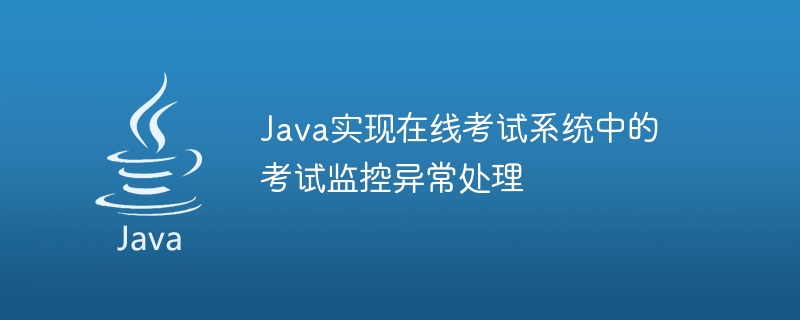Home >Java >javaTutorial >Java implements examination monitoring exception handling in online examination system
Java implements examination monitoring exception handling in online examination system
- WBOYWBOYWBOYWBOYWBOYWBOYWBOYWBOYWBOYWBOYWBOYWBOYWBOriginal
- 2023-09-27 08:37:53816browse

Java implements exam monitoring exception handling in the online exam system, which requires specific code examples
With the development of Internet technology, the use of online exam systems is becoming more and more widespread . The online exam system not only facilitates students to take exams, but also provides real-time monitoring functions to ensure the fairness and security of the exam process. This article will introduce how to use Java to implement examination monitoring exception handling in the online examination system, and provide specific code examples.
During the exam, you may encounter some abnormal situations, such as candidates suddenly disconnecting from the Internet, computer crashes, etc. These anomalies may result in the candidate's answers being lost, exam data being damaged, or even being unable to complete the exam. In order to avoid these abnormal situations from adversely affecting the exam results, we need to add an exception handling mechanism to the system to protect the integrity and security of the exam data.
First of all, we need to implement an exam monitoring module in the system, which is responsible for monitoring candidates' answers and abnormal situations. The following is a simple test monitoring code example:
public class ExamMonitor {
public void startMonitoring(Student student) {
try {
// 监控考生是否完成考试
while (!student.isExamCompleted()) {
// 监控考生的答题情况
// ...
}
} catch (Exception e) {
// 处理异常,比如记录日志、通知管理员等
// ...
}
}
}In this example, the startMonitoring() method continuously monitors the candidate's answering status through a loop. If an exception occurs, catch block to handle exceptions. You can add your own exception handling logic according to actual needs, such as logging, notifying administrators, etc.
In addition to the exam monitoring module, we also need to add exception handling mechanisms to other key places in the exam system. The following is a code example for candidates to submit test papers:
public class ExamSystem {
public void submitAnswerSheet(Student student, AnswerSheet answerSheet) {
try {
// 提交考生答卷
// ...
// 保存考生答卷到数据库
// ...
} catch (Exception e) {
// 处理异常,比如撤销考试结果、记录日志等
// ...
}
}
} In this example, the submitAnswerSheet() method is used by candidates to submit answer papers. If an exception occurs, catch block to handle exceptions. You can add your own exception handling logic based on specific business needs.
In addition to the above code examples, we can also use other Java exception handling mechanisms, such as using the try-catch-finally structure to protect code blocks. In the examination system, file systems, databases, or network technologies can also be used to store and transmit examination data. These places also need to implement exception handling mechanisms to ensure the integrity and security of the data.
To sum up, Java provides a powerful exception handling mechanism. We can protect the examination monitoring and data security in the online examination system by rationally using the exception handling mechanism. Whether it is the exam monitoring module or other key places, we can use try-catch to handle exceptions and add our own business logic. In this way, we can effectively handle abnormal situations in the online examination system and ensure the fairness and security of the examination process.
The above is the detailed content of Java implements examination monitoring exception handling in online examination system. For more information, please follow other related articles on the PHP Chinese website!

